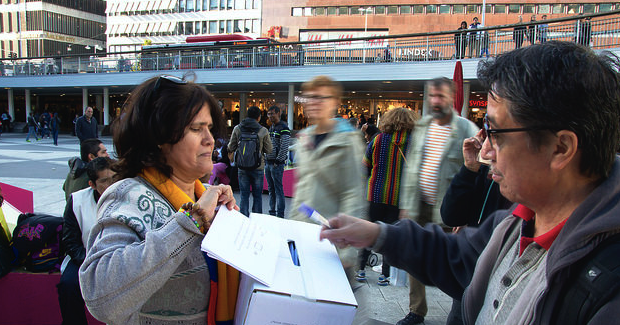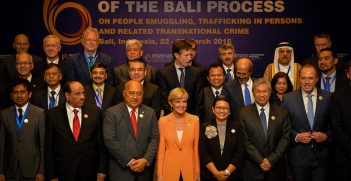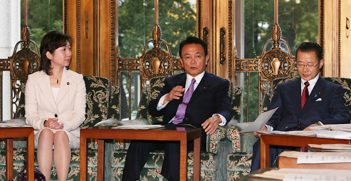Colombia Votes No: But is all Really Lost?

In a surprise outcome, the Colombian population has voted ‘No’ in the 2 October plebiscite to the final peace agreement between the Colombian government and the Revolutionary Armed Forces of Colombia, or FARC. With 99.98 per cent of votes counted, the plebiscite question: ‘Do you support the final accord for the end of the conflict and the construction of stable and lasting peace?’ received 6,431,376 ‘No’ votes, closely followed by 6,377,483 ‘Yes’ votes. With a ‘No’ vote at 50.21 per cent and a ‘Yes’ vote at 49.78 per cent, this marks less than half a per cent between those voting for peace with the FARC and those against.
President Juan Manuel Santos signed the final peace accord with the FARC at an official ceremony in Colombia on 27 September in Cartegena, Colombia. The agreement dealt with the five key agenda items in the current administration’s round of negotiations: rural and agrarian land reform, the nature of the FARC’s political participation, the solution to the illicit drug problem, how best to deal with the victims of the conflict in terms of transitional justice and repatriation, and how to end the conflict. Importantly, the Colombian government and the FARC agreed to a bilateral ceasefire marking the cessation of hostilities, and preparations have commenced towards post-conflict processes. For example, the FARC had begun to move towards 23 UN-monitored verification zones to commence the process of disarmament and reintegration. However, in light of the plebiscite decision, these processes have been temporarily stalled without a mandate that a successful plebiscite would have provided the presidency to implement the accords. Despite this unexpected result, does this mean that all in the four year negotiations are lost?
Reasons for a ‘No’ vote
Leading up to the plebiscite, polls demonstrated that there was in fact a clear lead for a ‘Yes’ vote. Should the ‘Yes’ vote been successful this would mark the end of the conflict with the FARC spanning over 52 years. Moreover, the final agreement dealt with key grievances that had traditionally framed the FARC’s political and military objectives and allowed for the transition from the battlefield to the political arena as a political party, with a guaranteed five seats in both the Senate and the House. The rural and agrarian reform provisions would allow for investment back into rural economic development, improving livelihood conditions for those living within the countryside. As such, there would be further government investment in social services and infrastructure, and the development of alternative illicit crop substitution in areas throughout the country. The agreement also included strong provisions for the inclusion of women in post-conflict processes, with both the Colombian government and the FARC agreeing to the necessity in creating a gender sub-commission overseeing the implementation of these gender inclusive provisions.
Yet a ‘no’ vote prevailed, significantly influenced by former President Álvaro Uribe who has consistently argued that the peace accord was too lenient. Uribe, a hard-handed president responsible for successful securitisation initiatives throughout the country, was particularly vocal against the FARC receiving guaranteed political seats and amnesty provisions. This echoed the sentiments of many in the broader Colombian public who felt that the government is granting too many concessions towards the guerrillas. In a conflict claiming over 220,000 lives since its inception, including more than 7,900,000 registered victims, a variety of stakeholders, including the FARC, have caused lasting damage—both physically and psychologically. Particularly in terms of providing justice to the victims, this becomes complicated when many FARC fighters will not receive jail sentences but rather smaller penalties. Furthermore, a guaranteed incorporation into the political structure despite these atrocities can be seen by some as the legitimation of violence. Questions remain as to where and how the Colombian government will obtain the funding for many of social initiatives outlined in the accords, despite vowed US assistance through the launching of Peace Colombia.
What happens now?
Regardless of the narrow success of the ‘No’ vote, this doesn’t mark the end of peace attempts with the FARC. In fact, it has the potential to strengthen it. Whilst the rejection of the peace accord marks a significant blow for the Santos administration, the plebiscite itself is non-binding and the task now reorientates to addressing the question as to why Colombians would vote ‘no’. Although voter turnout was very low at just under 40 per cent, what is clear from the results is that the regions most affected by the conflict voted ‘Yes’ to the plebiscite.
Despite staking his presidency on a mandate for peace, Santos recognised the success of the ‘No’ vote in a speech shortly after the results of the plebiscite. He vowed to continue the peace process with the FARC, stating that he would be committed to calling “on all the political forces—particularly those that demonstrated ‘No’ today—to hear them and encourage dialogue and determine the way forward”. The president confirmed that the chief negotiator, Humberto De La Calle, and the High Commissioner for Peace, Sergio Jaramillo, will head back to Havana to advise FARC negotiators on the nature of the results. Shortly after the president’s announcement, the FARC issued a communique stating that the insurgency “maintains its will for peace and reiterates its willingness to only use the word as a weapon of construction towards the future.”
What is clear is that the peace process will take longer than initially intended. Whilst the ‘No’ vote may be a disappointment to many, the commitment of both parties towards recommencing negotiations immediately in Havana signifies not only the strength of the accords, but the strong desire to obtain peace for the country. Despite the fact that this plebiscite is not binding and could be passed with certain amendments through the Colombian congress, Santos has reaffirmed his commitment to popular democratic processes and acting on the desires and opinions of the Colombian population. In vowing to work with stakeholders within the ‘No’ camp and include them directly in renegotiations of a final agreement, it potentially provides the opportunity for a more holistic framework respecting the wishes of greater sections of the population. Although the plebiscite’s outcome was a shock to many, it could in fact reorientate towards an agreement to achieve a more inclusive, consolidated and sustainable peace.
Alexandra Phelan is a Teaching Associate and PhD Candidate with the School of Social Sciences, Monash University. Her PhD research focuses on the Colombian government’s shifts between negotiation policies and counter-insurgency strategy against the FARC.
This article is published under a Creative Commons Licence and may be republished with attribution.





